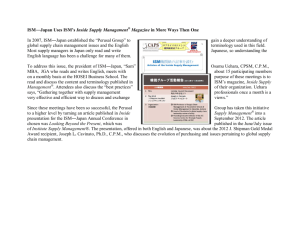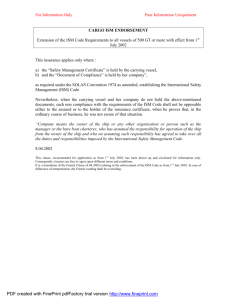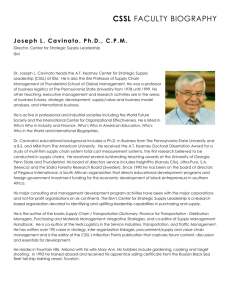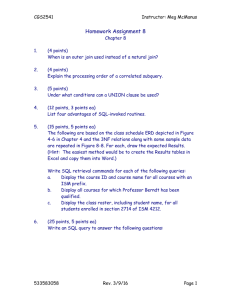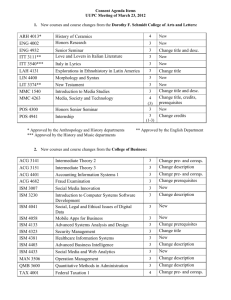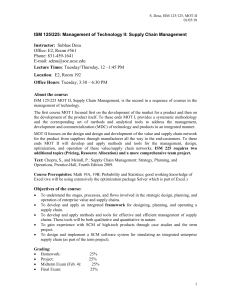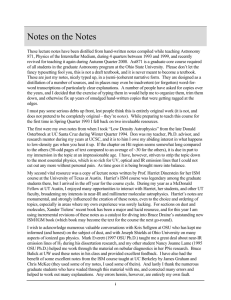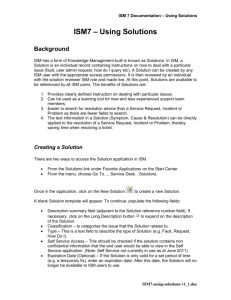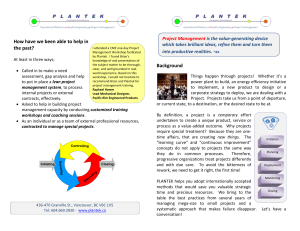Improving Safety Culture
advertisement
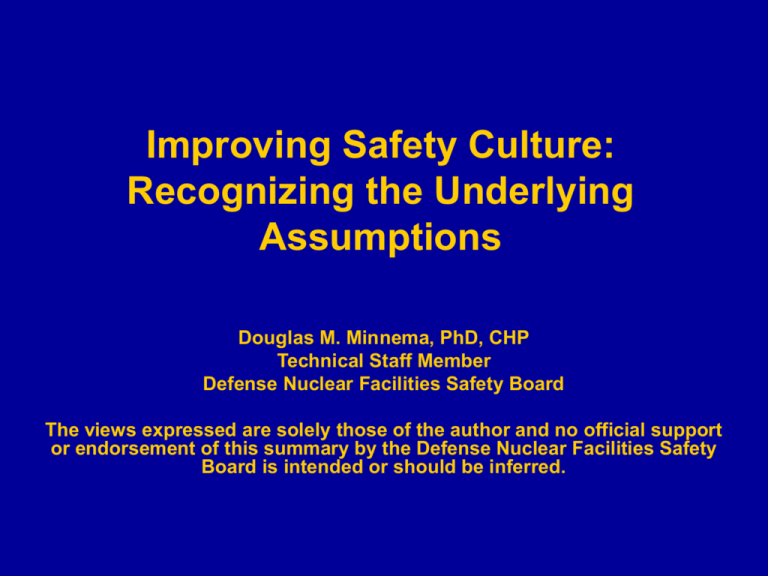
Improving Safety Culture: Recognizing the Underlying Assumptions Douglas M. Minnema, PhD, CHP Technical Staff Member Defense Nuclear Facilities Safety Board The views expressed are solely those of the author and no official support or endorsement of this summary by the Defense Nuclear Facilities Safety Board is intended or should be inferred. Purpose • To consider safety culture lessons learned from the Davis-Besse Reactor Pressure Vessel Head Corrosion Event of 2002 • To conduct a historical review of other significant incidents involving organizational weaknesses • To develop an event progression model, based on similarities between these incidents, to evaluate the underlying assumptions in safety culture ISM Workshop, November 2007 2 Background • INPO defines safety culture as: “An organization’s values and behaviors – modeled by its leaders and internalized by its members – that serve to make nuclear safety the overriding priority.” • Note that there are four underlying assumptions in this definition: – Quality leadership - Prioritization – Adequate span of control - Oversight ISM Workshop, November 2007 3 Background (con’t) • INPO explains organizational culture as: “The basic assumptions that have worked well enough to be considered valid are taught to new members of the organization as the correct way to perceive, think, act, and feel. Culture is the sum total of a group’s learning.” • “Real progress on safety can be made by understanding how people create safety, and understanding how … safety can break down in resource limited systems.” - Sydney Dekker ISM Workshop, November 2007 4 Consider • If culture is the sum of an organization’s learning, then a stable organization probably unwittingly compensates for its own weaknesses • Stability is maintained by peer pressure “training” of new workers to the in-place culture, unless external influences upset status quo • Weaknesses often undetected until upset occurs What happens when an organization is stressed by external influences? ISM Workshop, November 2007 5 External Influences • • • • • External Influences are conditions that are outside of organization’s span of control; the organization can respond to them but cannot eliminate them. Market or economic conditions Industry deregulation Externally controlled mission, budget, or schedule Public opinion of industry or its products Competing externally-driven priorities (e.g., security, environmental protection) ISM Workshop, November 2007 6 At Davis-Besse Over the several years before corrosion was discovered: 1. External market conditions drove managers to defer maintenance; undertake merger; delay upgrades 2. Workforce responded by reducing rigor; chasing symptoms not causes; raising informal issues threshold 3. Minimalist compliance approach evolved in organization, failed to recognize significance of emerging issues 4. Oversight processes were not effective, if conducted, in detecting changing organizational behaviors 5. Safety performance suffered general decline until corrosion was discovered & regulator intervened ISM Workshop, November 2007 7 Event Progression Model • This sequence suggests a general model: External Influences Create pressure Yes Does oversight recognize decline? Workers respond by changing behaviors Managers respond with org changes Yes No Safety Performance Declines No Significance to Safety recognized? Significant Event Occurs ISM Workshop, November 2007 8 Is the Model Valid? A review of major accidents and near-misses where organizational weaknesses were causal factors demonstrated the same event progression in 20 events: Apollo I Fire, 1967 USS Forrestal Fire, 1967 TMI-2 NPP Meltdown, 1979 Iran Hostage Rescue, 1980 UC Leak at Bhopal India, 1984 UC Leak at Institute WV, 1985 Davis-Besse NPP LORF, 1985 Challenger Explosion, 1986 Chernobyl NPP Explosion, 1986 Millstone NPP Shutdown, 1996 Maine Yankee NPP, 1996 Valujet #592 Crash, 1996 CA Electrical Brownouts, 2000 Davis-Besse NPP RPVH, 2002 Columbia Breakup, 2003 NE Electrical Outage, 2003 Los Alamos Lab Shutdown, 2004 BP Texas City Explosion, 2005 BP Prudhoe Bay Leak, 2006 USAF Weapons Handling, 2007 ISM Workshop, November 2007 9 Observations • Not all accidents develop in this manner, but the model does help understand how organizations react to external influences • “Good” leaders going in the wrong direction yields same result as “bad” leaders with no direction • Workers may follow managers’ lead, or they may reject managers and rebel against organization; either behavior leads to same results • “Repeat performances” demonstrates the inherent difficulties of establishing and sustaining a strong culture within large organizations ISM Workshop, November 2007 10 Observations (con’t) • External conditions strongly influence culture; while external conditions cannot be eliminated, their impacts on safety culture can be minimized through understanding and proper planning • The impacts of organizational changes on safety culture should always be evaluated before the change and then monitored after the change to validate assumptions & conclusions ISM Workshop, November 2007 11 Observations (con’t) • The model’s feedback loops of significance recognition and oversight are how a leader determines the health of the organization’s culture before an event occurs; they should never be neglected or ignored • The motivation to hold nuclear safety as the “overriding priority” requires leadership; an organization will follow its manager’s behavioral lead above the words; motivation cannot be ‘engineered’ into an organization “People do what people see.” John C. Maxwell ISM Workshop, November 2007 12 Cultural Indicators The value of a model is that one can identify metrics based on it to monitor the culture: – Changes in economic or market conditions – Changes in production/service demands – Changes in competing priorities – Changes in safety versus non-safety resource allocations – Changes in workers’ satisfaction with management – Changes in turnover/retirement rates ISM Workshop, November 2007 13 Cultural Indicators (con’t) – Changes in rate & nature of employee concerns or dissenting opinions – Changes in reportable events (up or down) – Changes in rate of deferred maintenance – Changes in rate of deferred/overdue training – Changes in fraction of events involving multiple programmatic breakdowns – Changes in rate & nature of interactions with regulators ISM Workshop, November 2007 14 Cultural Indicators (con’t) – Changes in rate of overdue/delayed audits – Changes in number or quality of findings – Changes in turnover rates of auditors and trainers – Changes in ratio of externally- versus internally-identified assessment/audit findings – Changes in rate of overdue corrective actions – Changes in ratio of self-disclosing versus selfidentified issues ISM Workshop, November 2007 15 Conclusions • The underlying assumptions provide the keys to shaping the organization’s behavior. • Quality leadership cannot be engineered, but can be developed; focus on creating a pool of future leaders. • Influences outside the organization’s span of control can have serious impacts on safety culture; understanding those influences helps limit their impacts. • The capacity to recognize the safety significance of issues, and the ability to optimally prioritize resources in response, require deliberate and constant attention • The organization’s cultural health must be constantly monitored through oversight, and early intervention into identified concerns is always warranted. ISM Workshop, November 2007 16 CLIMBING THE STEPS TO AN EFFECTIVE SAFETY CULTURE EMPOWERED WORKERS COMMITTED LEADERSHIP BALANCED PRIORITIES & RESOURCES TOOLS: VPP, QA, TRAINING, HPI, STANDARDS FOUNDATION: INTEGRATED SAFETY MANAGEMENT CHECKS & BALANCES SHARED DESIRE FOR EXCELLENCE •Selecting personnel based on values •Planning for succession •Building teams •Recognizing contributions •Sharing narratives and stories •Teaching & mentoring on core values •Developing future leaders •Cultivating a questioning attitude Safety Culture Organizational Practices Institutional Structures Management Systems OVERSIGHT LEADERSHIP Shared Values And Beliefs •Establishing procedures and practices •Analyzing and controlling work •Training & qualifying workers and managers •Ensuring continual competency •Determining the significance of issues •Gathering feedback and improving •Learning from other’s lessons •Identifying the standards & requirements •Assuring a quality operation •Finding and fixing issues •Determining the basis for safety •Understanding the technical basis •Strengthening institutional safety programs •Applying Integrated Safety, Safeguards & Security, and Environmental Management systems •Managing impacts of organizational change •Balancing priorities during budget formulation ISM Workshop, November 2007 18 Conclusions (con’t) • “Psychologists tell us that all humans have four basic needs: the need to feel comfortable, the need to be understood, the need to feel welcome, and the need to feel important.” – Mark Eppler • Improving safety culture is all about satisfying those four needs. To do so requires caring, motivational leadership; the ability to determine the significance of issues; and the capacity to continually monitor the culture’s health. ISM Workshop, November 2007 19
